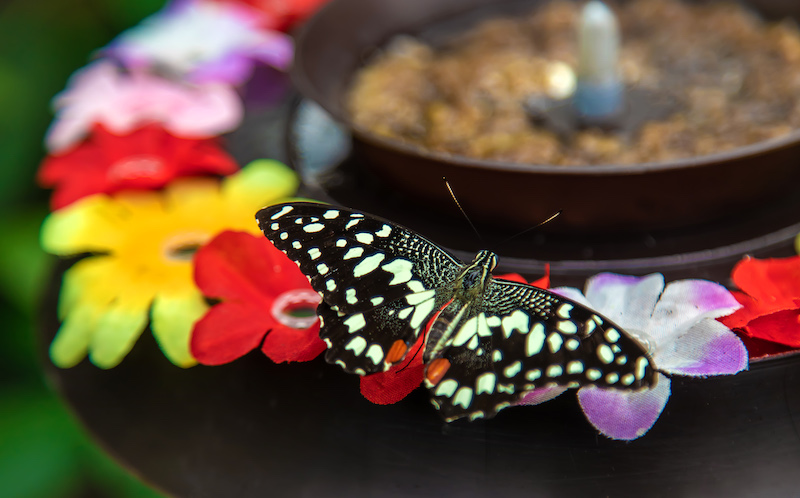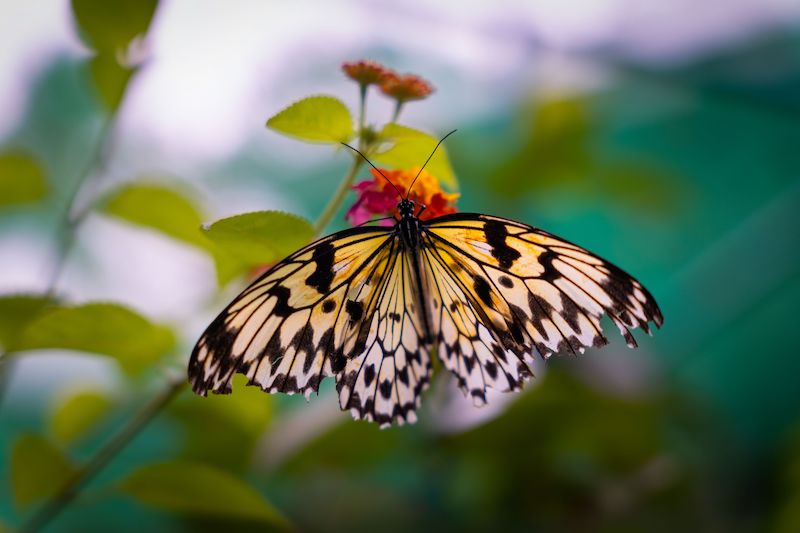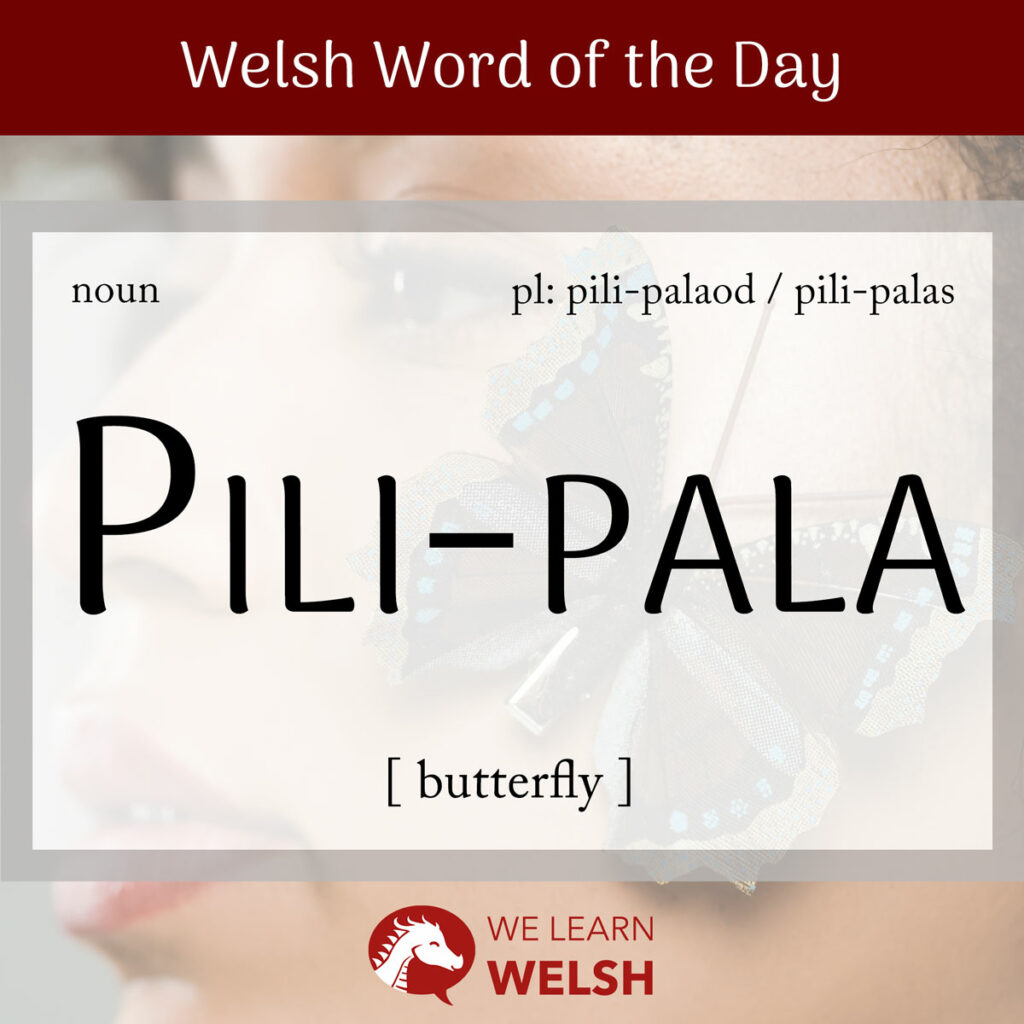Today’s word of the day is pili-pala, which is the Welsh word for butterfly. These insects are many people’s favourite due to their adenydd lliwgar (colourful wings). It’s also a fun word to say out loud!
pili-pala
butterfly
Pili-pala is a masculine noun and is susceptible to all three types of mutation:
Soft mutation
bili-pala
Nasal mutation
mhili-pala
Aspirate mutation
phili-pala
- Am bili-pala pert! = What a beautiful butterfly!
- Dyma fy mhili-pala. = Here is my butterfly.
- Blodyn a phili-pala = A flower and a butterfly
There are two possible plurals: pili-palaod and pili-palas.
There are lots of words for butterfly in Welsh, but there are only two that appear as often as pili-pala:
Firstly, we have glöyn byw. Glöyn is the Welsh word for a piece of coal (glo). Pay attention to the umlaut (two dots) above the o; this symbol tells you that you should pronounce the two vowels separately as o-y instead of together like in the word moyn (to want). Byw usually means alive, but in this case it means bright or lively. So, glöyn byw literally translates to bright coal. This seems to compare the bright colours of a butterfly’s wings to the glow of a hot coal. Glöyn also appears in the Welsh word for a type of bright yellow fish called a butterfly-fish in English: glöyn y môr or morlöyn.
The other common alternative to pili-pala is iâr fach yr haf which literally translates to little chicken of the summer – very strange indeed!
Peintiais i bili-pala ar ei hwyneb.
I painted a butterfly on her face.

Here are some rarer words for butterfly that you may come across occasionally:
- eilir/eilier
- colomen fyw (lit. bright dove)
- plufyn bach yr haf (lit. little feather of the summer)
Butterflies are not the only insect to have a strange name (enw rhyfedd) in Welsh. Here are some other trychfilod (insects) that have quirky Welsh names:
- gwas-y-neidr = dragonfly (lit. the snake’s servant)
- buwch goch gota = ladybird (lit. little red cow)
- Siani flewog (also called lindys) = caterpillar (lit. hairy Siani)
- mochyn coed = woodlouse (lit. tree pig)
- gwrach y lludw = woodlouse (lit. witch of the ashes)
Pili-pala comes from an older Welsh word for butterfly, pilai. So the Welsh word for butterfly has doubled in length over time! This is an example of a linguistic phenomenon called reduplication (dyddyblu), where a word or phrase is created by repeating a root word or a slightly altered version. For example, in English we have “mumbo-jumbo” and “easy-peasy”.
Pili-pala is an example of ablaut reduplication, where the vowel is changed in the second half of the word. There are several other examples of this in the Welsh language, for instance:
- chwit-chwat = scatterbrained
- igam-ogam = zigzag
- dibyn-dobyn = topsy-turvy
- dwmbwr-dambar = a chaotic clattering noise (for example, from someone running down the stairs)
All of these reduplicated words apart from dwmbwr-dambar follow an interesting vowel pattern that also shows up in English: i-a-o. The vowel pattern nearly always moves from left to right but all three of the vowels don’t always appear (for example, many reduplicated words skip straight from i to o). Some English examples include: tic-tac-toe, splish-splash-splosh, criss-cross, wishy-washy.
Fy hoff bili-pala yw’r gwyn mawr.
My favourite butterfly is the cabbage white.
Why does this strange pattern appear in both English and Welsh? One possible reason is that the tongue position required for these three vowels moves further back into the mouth as the pattern progresses. This means that it requires less effort to say i-a-o than a-i-o. Try it yourself! Can you feel that your tongue is at the front of your mouth for “i” but at the back for “o”?
The Welsh language also has examples of full reduplication, where the same root word is repeated to make a new word (like in the English goody-goody or bye-bye):
| WORD | MEANING | ROOT |
| ledled | throughout | lled (width) |
| da-da | sweets (similar to French bon-bon) | da (good) |
| mwyfwy | more and more | mwy (more) |
| llailai, lleilai | less and less | llai (less) |
Sadly, many species of pili-palaod are becoming mwyfwy endangered. According to the charity Butterfly Conservation, the diversity (amrywiaeth) of the Welsh butterfly population has decreased greatly since the 1970s. This is due to butterflies that rely on a specific habitat (cynefin) dying off and being replaced by species that can survive in a wider range of environments.
Since 88% of Welsh land is farmland (tir amaeth), it’s no surprise that farming practices often contribute to the decline of butterfly populations. A great deal of wildlife, including butterflies, rely on semi-natural grassland (glasswelltir) and cannot survive in fields that have been ploughed, reseeded or heavily fertilised. Since the 1930s, Wales has lost 90% of its semi-natural grassland, leaving these species homeless.
Other endangered species (rhywogaethau dan fygythiad) of butterfly lay their eggs (wyau) in farm hedgerows (cloddiau/gwrychoedd) which are trimmed annually. This removes most of the eggs and doesn’t leave enough leaves (dail) for any surviving caterpillars to eat once they hatch. Luckily, there is still time to save many of these butterfly species through reducing how often and how much farmers trim their hedgerows.
Here are the Welsh names for a few endangered butterflies:
- brith brown = high brown fritillary
- glöyn llwyd = grayling
- glesyn mawr = large blue

Wales is home to a lot of beautiful wildlife, as well as a beautiful language that gives these plants and animals weird and wonderful names. If we want to keep this tapestry of culture and nature alive, it’s important that we work together to protect and rebuild threatened habitats. Whether you have just moved to Wales or have lived here all your life, you can be part of this effort. I have every faith that together we can bring Welsh wildlife back from the brink; after all, we did exactly the same thing for our language!

